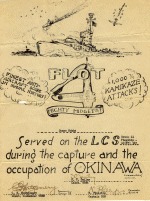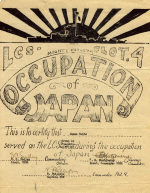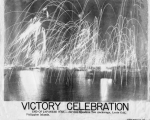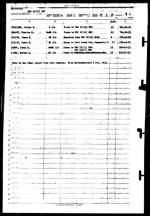NavSource Online: Amphibious Photo Archive
USS LC(FF)-367
ex
USS LCI(L)-367 (1943 - 1944)
Miscellaneous Memorabilia and Newspaper and Magazine Articles
Contributed by Steven Pollack
Click On Image
For Full Size Image |
Size |
Image Description |
Source
|
 |
1648k |
Certificate issued to USS LC(FF)-367 crew member James Hobbs for participation during the Capture and occupation of Okinawa Gunto campaign as a member of LCS(L)(3) Flotilla Four, Group Eleven |
Steven Pollack |
 |
1970k |
Certificate issued to USS LC(FF)-367 crew member James Hobbs for participation during the Occupation of Japan as a member of LCS(L)(3) Flotilla Four, Group Eleven |
Steven Pollack |
 |
79k |
Envelope from a letter home from James Hobbs LC(FF)-367. Showing censor stamp. |
Steven Pollack |
 |
570k |
A picture clipping from a navy newsletter printed on USS Ajax (AR-6). showing fireworks celebrating the end of the war with Japan in the Service Squadron Ten Anchorage, Leyte Gulf, Philippine Islands. On the back James Hobbs wrote this is where the [USS LC(FF)-]367 was at the time. |
Steven Pollack |
 |
384k |
USS LC(FF)-367 final Muster Roll, 2 October 1946 |
Steven Pollack |
Newspaper and Magazine Articles
New York Times July 9, 1945
RYUKYU GLORY WON BY LITTLE WARSHIPS
Picket Line Guarding Fleet Off Okinawa Balked Enemy
Air
Force in Blazing War.
ABOARD A FLAGSHIP, in the East
China Sea off Okinawa, June 26 (delayed)—The Navy threw a
picket line across “Bogey Highway” to keep Japanese ship
breakers out of Okinawa transport area.
These picket ships—none larger than destroyers—fought and
won the longest and hardest battle in the history of naval warfare.
They suffered the greatest losses in men and ships ever sustained by
the United States Navy, but they fulfilled their mission of keeping
the bulk of enemy aircraft out of the transport area, where vital
supplies for soldiers and marines were being unloaded. It is no
exaggeration to say that these little ships, which seldom have the
chances for glory given to the air-craft carriers and the
battleships, performed a major role in our great victory on
Okinawa.
An Epic in Naval Warfare
This
thrilling story, which can be told for the first time now that the
Okinawan campaign is won, constitutes an epic that will live forever
in the annals of the Navy. It is a story of tough little ships
and brave men whose extraordinary gunnery took care of the best the
Japanese air force could throw at our Okinawan operation.
They were at “General Quarters” more than 150 times
during the eighty-two days of land fighting on Okinawa. These
air alerts lasted from minutes to several hours, and came at all
hours of the night and day, the Japanese sent over one to 200
aircraft in a single attack. Only comp____??? few of the enemy
got through to the transport area.
Commanded by Commodore Frederick Moosbrugger, 44, of Philadelphia,
himself a hero of the naval fighting off Vella La Vella in 1943,
these little ship stood guard as much as sixty miles away from the
Hagushi anchorage. They were the sentinels to fight approaching
Japanese planes, surface craft and submarines.
The shattered Japanese fleet never got near our main anchorage, but
the pickets did have to cope with scores of small suicide boats
carrying powerful explosive charges, which naval men called
“skunks”. A few submarines were encountered and
depth charges dropped. Whether any submarines were sunk or
damaged has not been announced.
But it was the enemy aircraft,
which fighting men call “bogeys”, that made this the
toughest duty naval men have had to face in this
war.
THE 367 LCS, GROUP 11 FLAGSHIP, THAT JAMES “MAJOR”
HOBBS (Photo # 1015036703) FOUGHT ON DURING THIS BATTLE – James Hobbs at the top of
first gangway to the right.
Move Back and Forth
To form the picket line, the Navy stationed destroyers,
destroyer-escorts and LCS(L) craft in great arcs before the
approaches to Hagushi anchorages. Those pickets moved back and
forth throughout the day and night.
The enemy chose to fight the main battle along the picket line.
It is in itself a tribute to the men who manned this outer line to
report that the statistics on ships sunk or damaged in the battle of
Okinawa reflect the splendid manner in which they did their job of
keeping the enemy away from the crowed transport area that once
sheltered more than 1,00 ships.
One
out of every three ships that served on the outer picket line was
sunk or damaged in this fierce, never ending vendetta with the
“Kamekaze Kids”. Of the ships engaged at various
times in this duty, nine were sunk and twenty-one were damaged.
Our casualties among these ships exceed 1,000.
But the Japanese could not win. Guns of the ship on the outer
line accounted for 490 enemy aircraft.
Between the outer line and the transport area there was another
stream of light naval units, which took on the Japanese planes that
managed to get by the first group of pickets. During the
campaign we employed several hundred ships in this work, of which
three were sunk and more than a score damaged. It was the inner
screen that handled most of the suicide boats.
It was the fine work of these ships, especially their superb gunnery,
that demonstrated conclusively that Kamikaze weapon will never win
the war.
It cannot be denied that
this form of attack is damaging. But it could not destroy many
of the ships it hit, and it could not diminish the fighting spirit of
the brave officers and men who sailed them.
Time
Magazine, July 9,
1945
BATTLE OF THE SEAS
The Little Ships
The navy last week totted up its losses off Okinawa: 4,907 men killed
or missing, 4,824 wounded–nearly20% of its total casualties in
all oceans for the entire war. Okinawa was also the war’s
costliest operation for ships, according to the navy’s own
figures: 33 ships sunk, more than 50 damaged.
One of the big reasons for this damage was finally passed by
censors: the gallant little ships
(destroyers, destroyer escorts, LCS’s) which______? The “Picket
line” 25 to 50 miles above the main anchorage had _____ ?
_____? _____?. By staying out front, the little ships with the
thin hulls were able to warn the big transport and gunnery ships of
approaching Jap p_____?. But they became the first Okinawan
targets in the sights of the Jap _____? Planes, and they took the
greatest concentrated damage, plus more than ____? casualties.
But the little ships stuck to their picket line, and the men stuck to
their guns. They set a world’s antiaircraft record by
shooting down 490 planes during the 82-day battle. They went to
“General Quarters” 150 times. The picket linemen’s
spirit was set down for history in a message sent by one little ship
in April: “Have been hit by two suicide planes:
shot down the third: am taking damaged destroyer in tow”
.
Article: Time, July 9, 1945
This page is created and maintained by Gary P. Priolo

|




